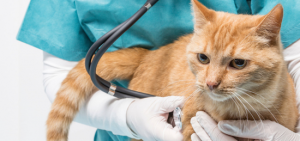 If your pet suddenly experienced a medical emergency or needed some quick medical care, here are some basics that will help all pet guardians be prepared to help animals in trouble.
If your pet suddenly experienced a medical emergency or needed some quick medical care, here are some basics that will help all pet guardians be prepared to help animals in trouble.
1. Have the right supplies ready:
It’s imperative to have certain necessities immediately at hand in case your animal friend suddenly needs your help. Create an animal first aid kit that contains at least these things:
- Emergency contact information: Always keep handy the phone numbers for your veterinarian, a nearby emergency after-hours veterinarian, and the ASPCA’s Animal Poison Control Center (1-888-426-4435; note that there is a fee associated with this call). You don’t want to be scrambling to find these numbers when you need them.
- Muzzle: Injured dogs often bite. Have an easy slip-on muzzle available. If you don’t have one, you can substitute strips of cloth, a necktie, a dish towel, a knee sock or any number of other soft fabric items. You may need to restrain a cat in a towel or pillow case, but be sure its nose is free to breathe. Never muzzle a vomiting animal, of course.
- Bandages and Gauze: You’ll need the non-stick kind, not the adhesive bandages you use on yourself when you cut your finger. Try to find the self-cling kind at a pet supply store. If you don’t have any, you can use strips cut from towels or other fabrics.
- Poison response supplies: Activated charcoal, hydrogen peroxide (3 percent) or milk of magnesia might mean the difference between life and death if your pet swallows something poisonous. Always contact a veterinarian for guidance before attempting to administer a treatment for poison or inducing vomiting.
- Digital thermometer: Buy a digital pet thermometer. A dog or cat’s normal temperature ranges from 100.5 and 102.5 degrees Fahrenheit, for example. Remember to take a temperature rectally, not by mouth. Lubricate with petroleum jelly first.
- A homeopathic first aid kit: Although homeopathy can be challenging to apply in chronic cases, it’s really quite easy for owners to effectively treat simple, acute cases with just a few remedies. If given shortly after symptoms are seen, the right remedy can help your dog or cat recover much more quickly. Having the right remedies on hand can be especially important if you don’t have immediate access to quality veterinary care … although they can also be a life saver while you’re driving on the way to the emergency vet!
- Rescue Remedy: This must-have Bach flower essence combination is useful for anxiety, shock and trauma and high stress situations, and can be useful for supporting a calm and peaceful state of being. Give a few drops between the cheek and gum or rub into ear base, on nose or paws; repeat as often as every 5 minutes if necessary.
Also keep on hand things like antiseptic wipes, disposable non-latex gloves, adhesive tape, a foil emergency blanket, tweezers, blunt-end scissors, ice packs, a leash, a pet carrier, an eye dropper, and a plastic non-needle syringe for administering oral medication, and towels. Know where your pet’s medical records are.
2. Know How to Safely Handle an Injured Animal
First, remain calm. Breathe and think clearly. If you are frantic, your pet will know that and become more fearful himself. If your dog is in a lot of pain and not vomiting, muzzle him. Yes, he’s your buddy, but pain and fear may make him snap at you nevertheless. If he’s been injured in a fight or other aggressive setting, he may still be amped up. Don’t put your face close to your injured pet and don’t hug him or her — it might hurt.
Don’t move an injured pet before checking him or her to determine what sort of injury he may have sustained. You may need to splint a broken bone or stanch some bleeding before you can transport him to your veterinarian’s office.
3. Basic Procedures To Learn Before Emergency Strikes
If you can, take a course from a knowledgeable source like the Red Cross about how to help your pet in an emergency. Learn how to administer cardiopulmonary resuscitation (CPR) on your dog or cat. Understand how to treat electrical shock or to care for injuries to the eye, feet and ears. Understand how to react in urgent care situations. When seconds count, you don’t want to be fumbling around, unsure of what to do.
4. Let Technology Assist You
Your smartphone can be your best ally in a pet medical emergency. Download the ASPCA’s Animal Poison Control mobile app or the Red Cross Pet First Aid app. Both offer substantial information that might mean the difference between life and death in an emergency.
Just as you should have plans in place for your family in the event of a fire or natural disaster, you need to pre-plan for a medical emergency for your furry family members. It’s the obligation of every pet guardian to know what to do at a moment’s notice when your companion animal is in trouble. Are you ready?

Recent Comments